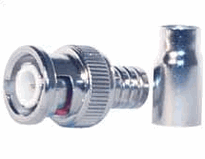CCTV Installation Information
Tools
You need a wire stripper.
A coax cable stripper is also handy.
If you are using crimp on BNC connectors you need a promper crimping tool.
If you are using solder on BNC connectors, you need a 30w soldering iron and some electronic type solder.
Camera Selection
Camera Positioning
Consider the type of coverage wanted, such as facial capture, general activity, license plate capture, and so on. Consider coverage before considering ideal physical camera mounting areas. Create a layout of building and cameras to be installed. If you have multiple cameras in a large area try to group your cameras into zones. This will allow you to better plan out how much wire you need to pull wire for multiple cameras in as few pulls as possible.
When planning for camera locations please take in consideration light condition, never install cameras in low light room pointing straight into the sunny area it will add glare to the picture, even if your camera has back light compensation it will not be enough.
Cabling
Under most circumstances RG6/U Quad Shield cable is ideal.
Crimp style connectors work well. Twist on connectors are not as good. Connectors requiring soldering are best.
 This is an example of a crimp on solderless RG6U BNC connector. Do not pay more than 75 cents each for these, even when purchasing in small quantities.
This is an example of a crimp on solderless RG6U BNC connector. Do not pay more than 75 cents each for these, even when purchasing in small quantities.
Most CCTV cameras and equipment use BNC type connectors, although there are some lower end cameras with RCA Composite stype connectors. Those can be easily adapted to BNC.
Video coaxial cable is designed to transmit maximum signaling energy from a 75 ohm source to a 75 ohm load with minimum signal loss. Excessive signal loss and reflection occurs if cable rated for other than 75 ohms is used. Cable characteristics are determined by a number of factors (core material, dielectric material and shield construction, among others) and must be carefully matched to the specific application.
The preferred dielectric material is foam polyethylene. Foam polyethylene has better electrical characteristics and offers the best performance over solid polyethylene, but it is more vulnerable to moisture. Use cable with solid polyethylene dielectric in applications subject to moisture.
For short cable runs, use RG59/U with a 22-gauge center conductor, which has a DC resistance of about 16 ohms per 1,000 feet (304 m). For longer runs, the 20-gauge variety which has a DC resistance of approximately 10 ohms per 1,000 feet will work well. In either case, cables with polyurethane or polyethylene as the dielectric material are readily available.
For installations requiring cable runs between 800 (244 m) and 1,500 feet (457 m),RG6/U is best. Having the same electrical characteristics as RG59/U, its outer dimension also is about equal to that of RG59/U.RG6/U comes in 500-,1000-and 2000-foot rolls, and it may be obtained in a variety of dielectric and outer-jacket materials. Due to its large-diameter center conductor of about 18 gauge,RG6/ U has a DC resistance of approximately 8 ohms per 1,000 feet (304 m) and can deliver a signal farther than RG59/U.
Use RG11/U to exceed the capability of RG6/U. Once again, the electrical characteristics of this cable are basically the same as the others. The center conductor can be ordered in 14-or 18-gauge sizes, producing a DC resistance of approximately 3-8 ohms per 1,000 feet (340 m). Being the largest of the three cables at 0.405 inches, it is more difficult to handle and install.RG11/U cable usually is delivered in 500-,1000-and 2000-foot rolls.
Because the characteristic impedance of coax cable ranges from 72 to 75 ohms, it is necessary that the signal travels on a uniform path along any point in the system to prevent any picture distortion and to help ensure proper transfer of the signal from the camera to the monitor. The impedance of the cable must remain constant with a value of 75 ohms.
More than 70% of installation problems are cabling related.
Be sure to use proper BNC connectors at end with proper cable crimping termination. The shield of cable should make 360 degrees continuous contact with the BNC connector.
Try to use single coaxial cable without any break. This will result in better results. If cable has to be joined, use BNC to BNC adapter, after terminating the cable ends with BNC connector. Note that 360 degree shield to shield continuity is required to avoid cable losses. Do not use twisted connections at any place.
Maintain minimum bending radius required for the cable. Bending radius smaller than 10 times diameter of the cable is not normally recommended. Avoid damage to cable during pulling. Stretching of cable during pulling will result in immediate or subsequent failures.
There are several types of terminating connectors
For example, PL-259 is used to terminate RG-11U cable, and BNC with RG-59U cable. Old CCTV systems used all PL-259 connectors which are larger than BNC connectors. Today, BNC connectors has become the connector of preference because of the smaller size, low signal loss, and ease of installation.
There are three basic types of BNC connector available.
- solder: The most durable and reliable, but difficult to assemble.
- crimp on: uses a sleeve crimped onto the stripped away insulator exposing the outer braid with a crimping tool
- screw on: slides onto end of cable and over exposed outer braid and forced on with a twisting action